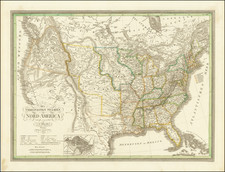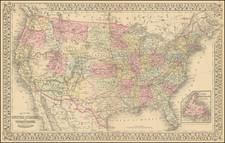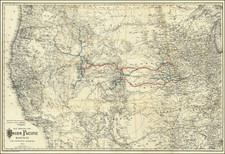Wyld's 1849 Map of the United States is one of the rarest and most fascinating maps of the United States published in the middle part of the 19th Century.
The map is a fascinating amalgam of information dating from Lewis & Clark to the early 1840s. The detail of the map is truly extraordinary, both in terms of content and as a snapshot of American history. The earliest information provided by the map includes a number of boundary lines and other details set in the years prior to Lewis & Clark. Lewis & Clarks' route to the Pacific and back is tracked, and the map includes several notes on the observations of the exploring party. An offshoot route from main route shows Colter's route in 1807. The map also provides a detailed treatment of the Pike Expedition, with notes, tracks and several block houses constructed by Pike. While instinct suggests that the map was probably rushed into production as a result of the California Gold Rush of 1849, the geography in the west pre-dates Fremont's explorations and includes the remnants of a number of the more fascinating mythical features of Western maps in the first half of the 19th Century. This is the one of the few maps that shows 3 Salt Lakes, Timpanagos, Teguayo (named Salt Lake) and the true location of the Great Salt Lake in Utah. Timpanagos even includes locations of an American Fur Company Depot, suggesting the map maker was unable to reconcile the location of this mythical lake against the location of the Great Salt Lake, which is includes a Mormon settlement and Ft. Mormon below. This is also one of the few maps of the period to depict the Camino Real in California, linking all of the Missions of Upper and Lower California. While the map clearly delineates the Guadalupe Hidalgo border following the conclusion of the Mexican War, the lack of detail in the California Gold Regions suggests that Wyld moved hastily to release the map, in order to meet demand.
It is entirely possible that the map is derived from Wyld's separately issued map of North America, which was first issued in 1823 and updated several times between 1823 and 1838, and spawned a derivative map in 1846. The extraordinary stove pipe extension of Texas (nearly reaching Ft. Laramie) and configuration of New Mexico is much more reminiscent of an 1846 date. Perhaps most fascinating of all is the overlay of multiple geographical names for the same region. This is especially prevalent west of the Mississippi River, where the Cape Girardeau District, St. Louis District, Lawrence District,Sioux District, Howard District, Arkansas District and DeVallier's Grant are still noted, as are Northwest Territory and a double wide configuration of Arkansas, to name but a few. The map is richly annotated, with many of the notes derived directly from (and citing quotes by) Humbolt, Lewis & Clark, Pike, Melish, Bouchette and several Spanish Sources. The detail in all of parts of the US and Canada are truly extraordinary. In addition to the fascinating details in the west, the details in the Upper Midwest, South and Southeast are all excellent, including early boundary lines with the Indians, a proposed Canal from the Amelia Island area to the Gulf, Arredondo's Grant and a second unnamed grant east of Tampa in Florida, Tennessee Company Lands in northern Alabama, Army Lands in Ohio, Northwest Company Houses throughout Canada and the Northwest, and many other notes on early boundaries, treaties, etc. The only example of the map which we could locate is the copy in the Historical Society of British Columbia.
The map is not in Rumsey and not identified by Rumsey in his survey of Wyld maps of North America and derivatives, nor were we able to identify any other references to the map in other institutional collections.
James Wyld Sr. (1790-1836) was a British cartographer and one of Europe’s leading mapmakers. He made many contributions to cartography, including the introduction of lithography into map printing in 1812.
William Faden, another celebrated cartographer, passed down his mapmaking business to Wyld in 1823. The quality and quantity of Faden’s maps, combined with Wyld’s considerable skill, brought Wyld great prestige.
Wyld was named geographer to Kings George IV and William IV, as well as HRH the Duke of York. In 1825, he was elected an Associate of the Institution of Civil Engineers. He was one of the founding members of the Royal Geographical Society in 1830. Also in 1830, his son, James Wyld Jr., took over his publishing house. Wyld Sr. died of overwork on October 14, 1836.
James Wyld Jr. (1812-87) was a renowned cartographer in his own right and he successfully carried on his father’s business. He gained the title of Geographer to the Queen and H.R.H. Prince Albert. Punch (1850) described him in humorous cartographic terms, “If Mr. Wyld’s brain should be ever discovered (we will be bound he has a Map of it inside his hat), we should like to have a peep at it, for we have a suspicion that the two hemispheres must be printed, varnished, and glazed, exactly like a pair of globes.”









![[ American Revolution - Satirical Warning To Dutch Commerce ] Den Door List en Geweld Aangevallen Leeuw.](https://storage.googleapis.com/raremaps/img/small/99580.jpg)

![United States History-Map (Five historical maps, including Toscanelli's Map of 1474) [Cover title:] Bacon's Excelsior Wall Atlases - America](https://storage.googleapis.com/raremaps/img/small/88839.jpg)

![Colton's Map of the United States The Canadas &c. Showing the Railroads, Canals, & Stage Roads With Distances From Place to Place…1856 [Pocket Map]](https://storage.googleapis.com/raremaps/img/small/85342.jpg)
